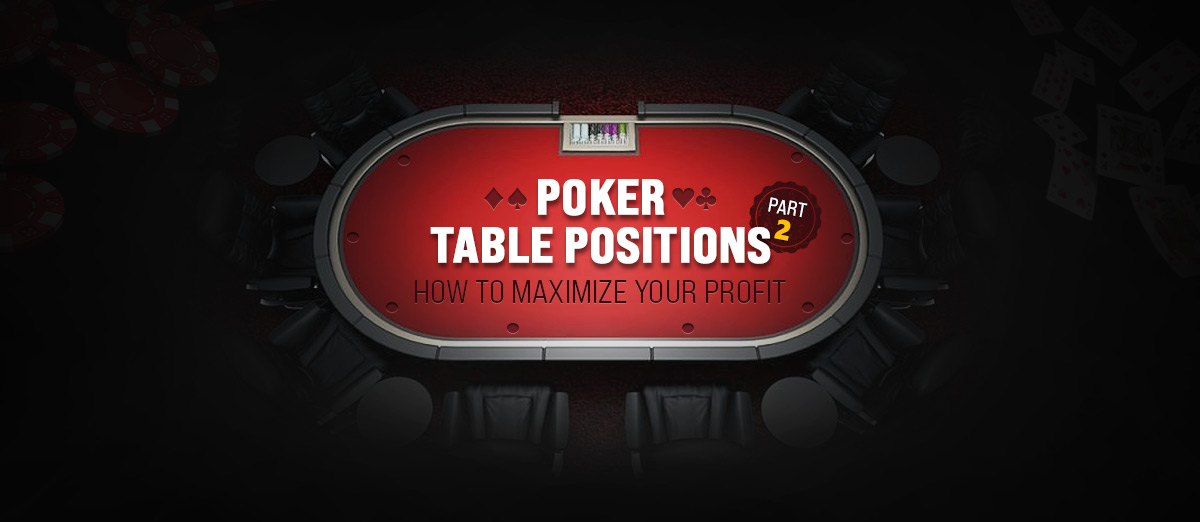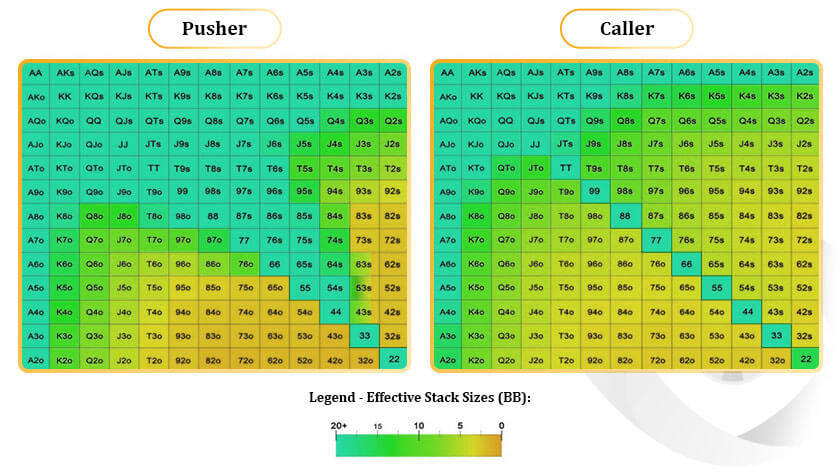How to Maximize Your Profit from Different Poker Table Positions in MTTs

The importance of position in poker cannot be overstated, no matter which format you play. That said, MTT (multi-table tournament) players can gain even more value by mastering positional play since it is one of the most important tools to use in every tournament stage.
If you want to be a great MTT player, you will need to know how to play in different stages and adjust your strategy based on your position at the poker table, and I will discuss some of the most important adjustments you can make to have better results.
Playing in Early Positions: Tight Is Right
The early positions are not those in which you will make the majority of your profit in tournaments, simply because they don't give you the positional advantage over the rest of the table.
In the early stages of poker tournaments, I recommend playing extremely carefully and tight from the early positions.
If you are sitting in the UTG or UTG+1 in the early stage, you should only be playing with a very tight range of very strong hands, mixed with a few playable bluffing hands like 98s and A5s.
I often see recreational players limping their suited connectors and small pocket pairs in early positions, hoping to call a raise if there is one and see a flop.
This is an absolutely bad idea, as you will be playing against a range made up of stronger hands, out of position, and without the power of being the pre-flop aggressor.
Limping with hands like KJ or QT is even worse, and I would recommend folding these hands in all cases, with hands like KQs really being the bottom of your opening range, along with pairs such as 55 or 66.
Things don’t really change much as the tournament progresses and you get shorter stacked compared to the blinds, as playing more hands under such circumstances is also not a good idea.
Playing even tighter at shallower stack sizes and taking the small pairs out of the opening range is usually a good idea until you reach the push or fold phase.
If there are many aggressive players at the table, you will want to play very tight, expecting them to make plays often and give you a chance to 4-bet shove (all-in).
Overall speaking, early positions are among the easiest to play in tournament poker, as you should not be getting involved too much, and the hands you do get involved with will usually be those that aren’t too difficult to play.
Middle Positions in Tournaments: The Hardest to Play
In my opinion, middle positions are the most difficult to play in tournament poker. There are many reasons for this, and it is true at almost any stack size.
In the earlier stages of the tournament, when there are many chips in play, you will be looking to play some speculative hands such as suited connectors or pocket pairs against early position opens.
The logic here is that early positions should be opening with a strong range and flopping big hands such as two pair or a set against them can be extremely profitable.
If you are first into the pot, you should open up your range a bit compared to your EP opening range, adding hands like 87s, QJs, JTs, and all pocket pairs. I still don’t recommend opening off-suit hands or disjointed suited cards.
The idea of stealing the blinds should start crossing your mind as the blinds go up and the stacks get shallower, but the fact you will have to get through late positions and players in the blinds means you should not expect it to work too often.
More often than not, you will face at least a call from the big blind, while getting called or 3-bet by the in-position players will be extremely uncomfortable.
For all these reasons, I recommend a balanced strategy that includes a decent amount of playable bluffs, such as all suited aces and many powerful broadway hands with blockers as your opening range.
When facing 3-bets, calling too much, especially against cutoff and button 3-bets, will definitely be a mistake, so you should start expanding your 4-betting range to include some bluffs.
Against active players who 3-bet a lot, you should be looking to add hands like small, suited aces to your 4-bet shoving range to make sure you aren't getting bluffed out of too many pots and can actually profitably steal the blinds with a reasonably wide range.
Overall speaking, middle positions are the most difficult to play as they will put you in many difficult and close spots in which making the right decision will require a lot of experience and a deep understanding of how different hand ranges play against each other.
Late Positions in Tournaments: Steals and Re-steals Galore
Late positions, namely cutoff, and button are the two spots in tournament poker in which you are going to be making the most of your chips.
The early phases of the tournaments are the time to play many speculative holdings, trying to make big hands like flushes or straights and get paid by the weaker players who are still in the field.
You should not care too much about stealing the blinds initially because you will be hundreds of blinds deep, and the steals will not be as important.
Once the blinds get bigger and the antes kick in, it’s time to steal the blinds and re-steal against the middle position opens.
The big advantage of playing in late positions is that you can start to really open up your raising range in unopened pots, as you will have very few people to get through and the ultimate positional advantage.
You should open well over 50% of your hands if you are first in on the button and slightly less if you are first in and sitting in the cutoff position.
The button also gives you the ability to 3-bet fairly wide against the middle and other late position opens, as you have the positional advantage and the ability to put all the pressure back on them.
I recommend adjusting to the table and re-raising very wide against a table of passive players who will not 4-bet you without strong hands, as this gives you the ability to steal pots post-flop as well once they miss the board and check to you.
If you are playing it right, the button will be the position from which you will play the most hands and make the most chips, as you get to over-realize your equity by continuing your aggression and denying your opponents from seeing turn and river cards.
Playing in the Small Blind: 3-Bet or Fold
The small blind is the worst position at the table from a positional point of view, as you are always forced to play from out of position against every single player at the table.
For that reason, it is a position from which you should not get involved too much, despite the supposed discount you are getting on calling raises.
In modern poker theory, the small blind is a position from which you should mostly 3-bet or fold, simply because seeing a flop out of position puts you at an immediate disadvantage.
By choosing to 3-bet the hands you want to play, you give yourself the added benefit of being able to win the pot pre-flop without having to face playing multiple streets out of position.
Things change quite a bit when the action is folded to you in the small blind, as you can open about 70% of your hands or go all-in with a wide range as the stacks get shorter.
For perfect unexploitable shoving ranges, I suggest you look at Nash equilibrium push/fold charts. These charts are intended to give you an example and to illustrate a heads-up play in tournaments with only two players against each other. They can be used when every player at the table folds to the small blind (SB) and decides what hands to move all-in with and calls part for the big blind (BB).
Nash Push/Fold Equilibrium chart example:

The best tip I can give you for playing out of the small blinds in tournaments is to stay relatively tight, not get involved in too many hands, and play aggressively when you get a hand that forces you to give action.
Playing in the Big Blind: Defend When It’s Cheap
The big blind is another interesting position in tournament poker. While it is not really possible to be profitable when you are forced to pay one big blind without seeing your cards, there are many ways you can limit your losses.
For starters, you should be smart about defending your big blind.
Against small raises, you will need to defend a wide range of hands, regardless of the fact they may not look too appealing. You are simply getting too good of a price, especially with antes in play.
Having to play out of position will, of course, limit the damage you can do with your hands in the big blind, but this still doesn’t mean you should let people abuse you and take your blind every time.
When it comes to 3-betting, I recommend doing so with a polarized range, made up of very strong hands and some playable bluffs. All medium-strength hands should be played as calls, as the price you will be getting great odds for the most part.
Defending a lot of hands in the big blind means you will have to play some poker post-flop, so you will need to learn how to play out of position on various boards, which is a challenge in itself.
It gets a bit easier when you get shorter stacked since you can start reshowing against late position opens and quickly build your stack.
Generally speaking, the big blind is a position in which you will get involved quite a bit and have to fight from behind, making it another tricky spot. Playing well in the big blind is one of the things that separates great tournament players from average ones.





Review this Blog
Leave a Comment
User Comments
comments for How to Maximize Your Profit from Different Poker Table Positions in MTTs